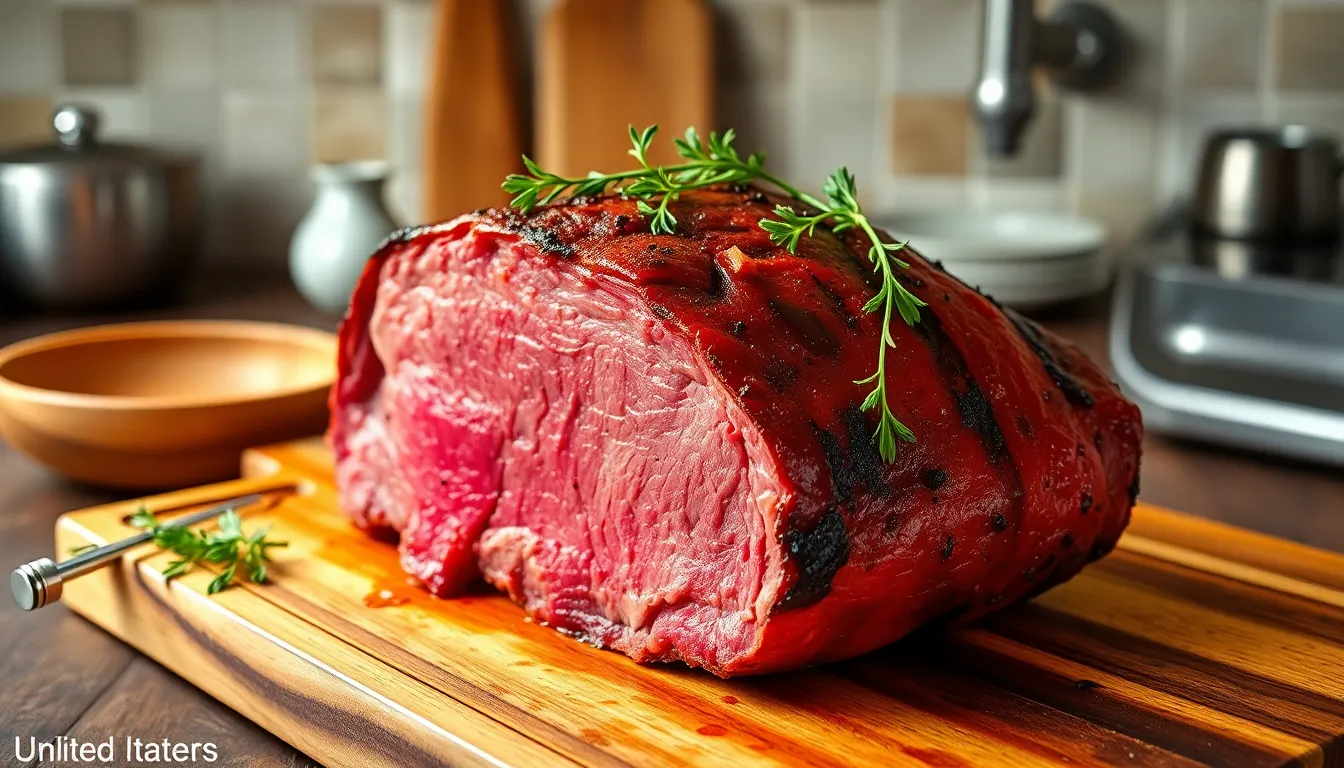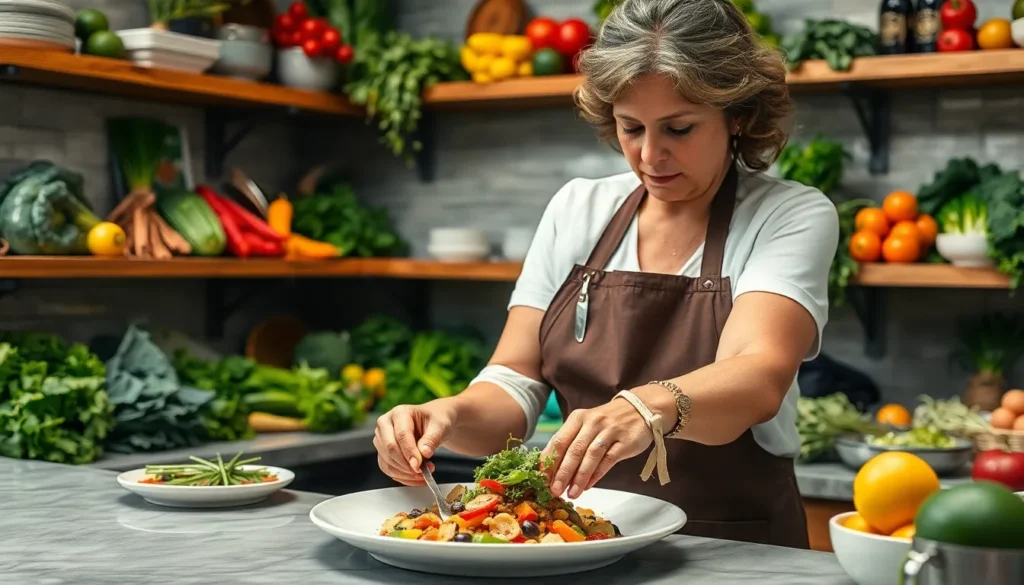Cooking the perfect prime rib roast is a culinary art that can elevate any gathering. This mouthwatering cut of beef, known for its tenderness and rich flavor, deserves careful attention to achieve that ideal medium-rare center. However, many home cooks often wonder just how long to cook prime rib roast to ensure it turns out succulent and juicy.
Understanding the right cooking time is crucial for success. Factors like the roast’s size and cooking method play a significant role in determining the perfect doneness. With the right guidance, anyone can master this impressive dish and impress family and friends alike. Let’s explore the essential tips and techniques for cooking prime rib roast to perfection.
Table of Contents
ToggleUnderstanding Prime Rib Roast
Prime rib roast stands out for its tenderness and rich flavor. Knowledge about this cut enhances the cooking experience and ensures optimal results.
What Is Prime Rib Roast?
Prime rib roast, also known as standing rib roast, consists of the ribs from the primal rib section of beef. It typically includes seven ribs, though a cut can range from two to seven ribs, influencing the overall size and cooking time. This cut is well-marbled, which contributes to its juiciness and flavor profile. When properly prepared, prime rib roast offers a melt-in-your-mouth texture that appeals to meat lovers.
The Importance of Cooking Time
Cooking time significantly affects the quality of prime rib roast. Proper timing ensures tenderness and optimizes flavor. Factors influencing cooking time include the roast’s weight and desired doneness. For example, a general guideline suggests cooking at 325°F (163°C), allowing approximately 15 to 20 minutes per pound for medium-rare results. Monitoring internal temperature with a meat thermometer aids in achieving the perfect doneness, with 130°F (54°C) recommended for medium-rare. Understanding these elements promotes consistent, delicious outcomes when preparing prime rib roast.
Factors Influencing Cooking Time

Cooking time for prime rib roast varies due to several critical factors. Understanding these factors helps achieve the desired result efficiently.
Cut Thickness
Cut thickness plays a significant role in determining cooking time. Thicker cuts require longer cooking periods, while thinner cuts reduce cooking time. A standard rule of thumb is to allocate about 15 to 20 minutes per pound for a roast that is 3 inches thick. For cuts exceeding 4 inches, consider extending the cooking time to ensure even doneness throughout.
Desired Doneness
Desired doneness influences cooking time significantly. Different internal temperatures correspond to varying degrees of doneness. For medium-rare, target an internal temperature of 130°F (54°C). For medium, aim for 140°F (60°C), while medium-well falls between 150°F (65°C) to 155°F (68°C). Each increase in doneness requires an additional 5 to 10 minutes per pound of roast, so one should continuously monitor the internal temperature throughout the cooking process.
Cooking Methods for Prime Rib Roast
Various methods exist for cooking a prime rib roast, each producing unique textures and flavors. The choice of method can significantly affect the final outcome, allowing for tailored approaches based on preference and available equipment.
Oven Roasting
Oven roasting remains the most popular method for cooking prime rib roast. This technique enhances the roast’s natural flavors while creating a caramelized crust.
- Preheat the oven to 325°F (163°C): This temperature allows for even cooking and optimal tenderness.
- Season liberally: Use a mix of salt, pepper, and herbs for enhanced flavor. Create a rub, if desired, to infuse the roast with additional depth.
- Place the roast in a roasting pan: Position it fat side up to baste the meat in its own juices.
- Insert a meat thermometer: This ensures accurate readings of internal temperature without opening the oven frequently.
- Roast time: Aim for 15 to 20 minutes per pound for medium-rare. For example, a 5-pound roast typically requires 1 hour and 15 minutes to 1 hour and 40 minutes.
- Rest before serving: Allow the roast to rest for 20 to 30 minutes after cooking to retain juices, ensuring a succulent result.
Sous Vide
Sous vide cooking offers precision and consistency, ideal for achieving desired doneness throughout the roast.
- Seal the roast: Place the seasoned prime rib in a vacuum-sealed bag. This technique locks in moisture and flavors.
- Preheat sous vide water bath: Set the temperature to the desired doneness. For medium-rare, set it to 130°F (54°C).
- Cook for an extended period: Submerge the bag in the water bath for 6 to 10 hours. The longer cooking time allows for tenderizing the meat effectively.
- Sear after cooking: Once the sous vide process is complete, remove the roast, pat it dry, and sear it in a hot skillet or oven for a few minutes. This step creates a flavorful crust.
- Let rest briefly: Allow the roast to rest for about 10 minutes before slicing, ensuring a juicy outcome.
Using these cooking methods, home cooks can achieve exceptional prime rib roast results that meet specific preferences for flavor, texture, and doneness.
How Long To Cook Prime Rib Roast
Cooking times for a prime rib roast depend on its weight and desired doneness. Understanding these factors ensures a perfectly cooked roast that’s both juicy and flavorful.
General Cooking Times
Cooking times vary according to the weight of the prime rib roast. The standard guideline is 15 to 20 minutes per pound at a temperature of 325°F (163°C) for medium-rare. Below is a table detailing approximate cooking times based on weight:
| Weight of Roast (lbs) | Cooking Time (minutes) | Cooking Time (hours) |
|---|---|---|
| 2 | 30-40 | 0.5-0.67 |
| 3 | 45-60 | 0.75-1 |
| 4 | 60-80 | 1-1.33 |
| 5 | 75-100 | 1.25-1.67 |
| 6 | 90-120 | 1.5-2 |
| 7 | 105-140 | 1.75-2.33 |
Thicker cuts require additional cooking time. For roasts exceeding 4 inches in thickness, add 10 to 15 minutes per pound to achieve even doneness.
Using a Meat Thermometer
Using a meat thermometer provides an accurate way to check for doneness. Insert the thermometer into the thickest part of the roast, avoiding contact with bone. Ideal internal temperatures for various levels of doneness are:
- Rare: 120°F (49°C)
- Medium-rare: 130°F (54°C)
- Medium: 140°F (60°C)
- Medium-well: 150°F (65°C)
- Well-done: 160°F (71°C)
Remove the roast from the oven when it’s 5°F (3°C) below the target temperature, allowing it to rest for 15 to 20 minutes. Resting redistributes juices, enhancing flavor and moisture.
Tips for Perfectly Cooked Prime Rib Roast
Achieving a perfectly cooked prime rib roast requires attention to detail during both preparation and cooking. Here are critical tips for optimal results.
Resting Period
Allowing the roast to rest is essential for enhancing flavor and moisture. It’s recommended to let the roast sit for 15 to 20 minutes after removing it from the oven. During this period, the juices redistribute within the meat, preventing them from spilling out when sliced. This resting time results in a more succulent and tender roast, offering a better dining experience.
Seasoning Recommendations
Proper seasoning elevates the taste of a prime rib roast. Several techniques can enhance flavor:
- Salt: Generously apply kosher salt on all sides of the roast at least 30 minutes before cooking. This process helps to lock in moisture and create a flavorful crust.
- Pepper: Use freshly cracked black pepper for a robust flavor. It pairs well with the natural richness of the beef.
- Herbs: Incorporate fresh herbs like rosemary or thyme. Rub the herbs with minced garlic and olive oil to create a paste for an aromatic crust.
- Dry Rubs: Consider using a dry rub that includes spices like paprika or onion powder. This adds depth and complexity to the roast.
Experimenting with various seasoning combinations can help achieve a personalized flavor profile that enhances the prime rib roast.
Cooking a prime rib roast to perfection requires attention to detail and a keen understanding of timing. By following the recommended guidelines for cooking time and temperature, home cooks can achieve a succulent and flavorful roast that’s sure to impress.
Utilizing methods like oven roasting or sous vide allows for flexibility in preparation while enhancing the meat’s natural qualities. Remember to let the roast rest before slicing to ensure maximum juiciness and flavor. With the right techniques and a little practice, anyone can master the art of cooking prime rib roast.






